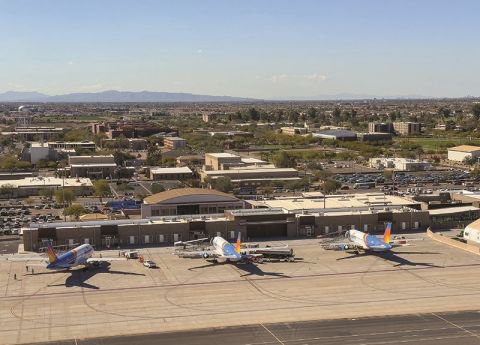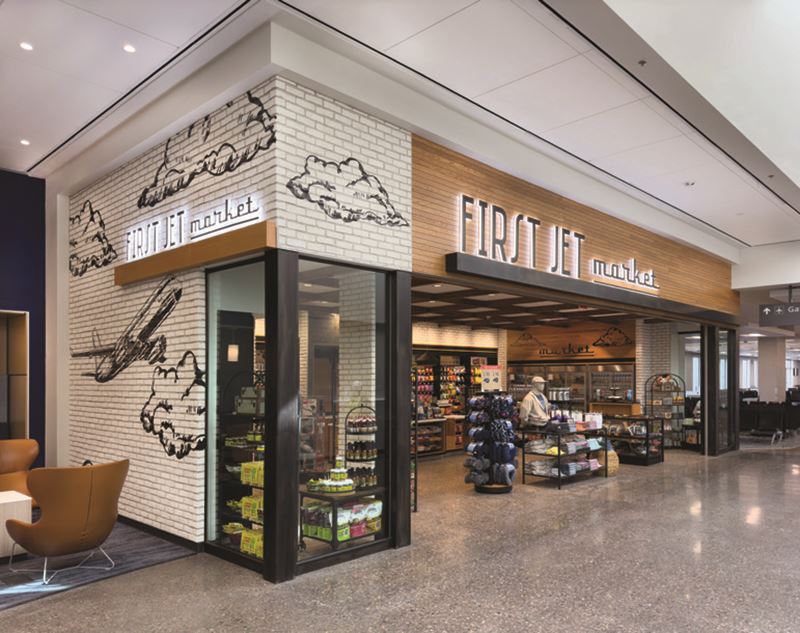Phoenix-Mesa Gateway Completes Five-Gate Addition

With an eye on growth and a heightened commitment to passenger comfort, Phoenix-Mesa Gateway Airport (AZA) unveiled a 30,000-square-foot terminal expansion in mid-February. The $28 million addition includes five ramp-loading gates, new concessions and—perhaps most importantly—enhanced functionality that was sorely lacking in the previous layout.
Located about 30 miles southeast of Sky Harbor International (PHX) in the East Valley region of Phoenix, AZA was a longtime military training site. For three decades, it has enjoyed a second civilian life hosting a mix of scheduled service and diverse types of general aviation traffic. Leisure-focused carriers Allegiant Air and Sun Country Airlines serve 45 U.S. markets from AZA, propelling it to an annual record of nearly 1.92 million passengers in 2023.
Despite the airport’s success, Executive Director and Chief Executive Officer J. Brian O’Neill recognized that AZA was limited by imbalanced infrastructure. Four of its 10 holdrooms—the oldest—were housed in 15-year-old modular trailers that collectively included just 10,000 square feet of space They were cramped, lacked adequate airflow and were generally seen as a poor fit for AZA’s evolving customer base.
|
Project: Terminal Expansion Location: Phoenix-Mesa Gateway Airport Size: 5 gates, 30,000 sq. ft. (replaced 4 gates spread over 10,000 sq. ft.) Cost: $28 million Outside Funding: $20.4 million in federal support (Bipartisan Infrastructure Law; Airport Improvement Program funding); $4 million-$5 million from the state of Arizona Design: DWL Architects + Planners Inc. Contractor: McCarthy Building Companies Inc. Construction: Sept. 2022 through Feb. 2024 Holdroom Furnishings: Airport Seating Alliance Temporary Holdroom Facility: Sprung Instant Structures Inc. Life Safety Systems: Firetrol Inc. Camera & Security Systems: Southwest Integrated Solutions Fire Suppression Systems: AZ Verde 2023 Passenger Volume: Nearly 1.92 million Traffic Profile: Active general aviation customer base; nonstop commercial service to 45 U.S. markets by Allegiant Air & Sun Country Airlines |
“The pandemic showed these spaces were substandard and unhealthy if more than one plane was on any of the four (modular) gates,” O’Neill says, adding that this setup effectively reduced the airport to a maximum of seven concurrent arrivals. “Now we’re able to simultaneously handle 11 flights at a time, meaning we have additional capacity for airlines that are looking to come in and serve this market.”
Major Transformation
The airport was largely dormant between 1993, when Williams Air Force Base closed, and 2007, when Allegiant established service there. After the low-cost carrier’s arrival, growth at AZA wasn’t just steady, it took off exponentially, reports Sandra Kukla, president of DWL Architects + Planners Inc., the locally based consultant that has guided the airport’s growth for nearly two decades beginning with a 2007 master plan.
For expediency, AZA’s original four gates used modular trailers, rolled in on wheels, for holdroom space and other passenger necessities. In all, the terminal was designed and built in just six months. “That was our original ‘Get ‘er done’ project,” quips Kukla.
Permanent gate facilities were added in 2010, 2012 and 2014, but there was never a seamless flow between the various phases. Passengers had to go outside to move between buildings, some of which had no concessions. Now travelers can stand at Gate 1 and look down to the opposite end of the terminal.
“We’ve done a complete transformation,” O’Neill says. “There’s no comparison.”
DWL Architects + Planners Inc. was the prime design firm, and its 25-person team also provided civil, mechanical, plumbing and structural engineering services.

Thomas Assante, a project director for McCarthy Building Companies, was involved in the terminal modernization from its inception. He says the work was challenging because the project site was an island surrounded by critical facilities such as baggage handling systems, a parking lot and active aircraft gates. Landside access to the jobsite was consequently impossible, and more than 300 crew members obtained TSA-authorized badges to work in the security identification display area.
“We had to be very detailed in our planning well in advance so that as we were building, we could do so with no impact and zero interruptions,” Assante explains.
One critical step was performing an underground utility investigation before physical construction began. Based on the results, crews relocated some utilities, connected into others, and removed or abandoned unnecessary lines. Some dated back to the airport’s days as a World War II-era military base.
“We didn’t have very many surprises,” Assante says, crediting McCarthy Project Manager JJ Blaschke, Project Superintendent Jeremy Wattleworth, DWL and the AZA team for their close coordination. Work wrapped up well ahead of schedule, he adds.
 “They were on top of it as far as getting us the information we needed to keep things moving,” he says.
“They were on top of it as far as getting us the information we needed to keep things moving,” he says.
Adds Kukla of the partnership: “They set themselves up for success.”
Necessity Drives Innovation
Construction of the terminal expansion began in September 2022, right on the heels of a three-year project to replace the outdated air traffic control tower at AZA.
First on the team’s “To Do” list was determining how to remove 40% of the airport’s existing gates without significantly affecting passengers and air carriers. Bob Draper, director of Engineering and Facilities, found the answer in an unexpected place: tribal casinos. Draper was impressed by the tensile fabric structures some Native American communities have erected as temporary gaming spaces while building permanent casino structures nearby.
 Research verified that a temporary terminal could work at AZA, “And we could reuse it for future needs,’“ Draper explains.
Research verified that a temporary terminal could work at AZA, “And we could reuse it for future needs,’“ Draper explains.
Following a competitive search process, the airport contracted with Sprung Instant Structures, a Utah-based manufacturer with patented fabric membrane technology that enables the rapid installation of enclosed commercial spaces. Rather than losing four gates, the airport closed only one aircraft parking pad to accommodate a 6,500-square-foot tentlike structure. It was fitted out with more than 300 seats to serve as a fully insulated, temperature-controlled holdroom space for three active aircraft gates.
“In about 12 weeks, we built out a fully functional terminal,” Assante reports, noting that critical tie-ins for security cameras, life safety equipment and fire alarm systems were performed during off-hours or between flight banks to minimize interruptions.
After the temporary structure was in place, crews demolished the existing facilities to make way for new construction.
Passenger Amenities
The design concept for the terminal addition is “a walk through the desert.” Floor-to-ceiling glass walls highlight outdoor areas where travelers can enjoy fresh air and the Arizona sun. Connecting pathways were designed to meander in the pattern of a desert wash. An expansive mural depicts the nearby Superstition Mountains, and a live saguaro cactus was relocated to remind travelers they’re in the Sonoran Desert. As hoped, the saguaro has become a popular photo opportunity for travelers.

The new terminal features colors and textures of the Sonoran Desert and nearby Superstition Mountains.
New concessions include Panera Bread and First Jet Market, a combination news/gift shop and grab-and-go food retailer. Arizona staples O.H.S.O. Brewery and Macayo’s Mexican Food, two sit-down dining options with indoor and outdoor seating, are particularly popular with snowbird customers returning home to colder regions. “There are a lot of people who’ll wait until the last possible moment to get onto that plane,” laughs O’Neill.
 Kukla notes that adding outdoor areas was a cost-effective way to provide value for passengers. “They just love to be outside,” agrees DWL Project Manager Shawn Filip.
Kukla notes that adding outdoor areas was a cost-effective way to provide value for passengers. “They just love to be outside,” agrees DWL Project Manager Shawn Filip.
Comfort and sustainability were additional design considerations. Holdrooms were placed close to aircraft parking envelopes to decrease distances from planes to the terminal. Inside the new facility, charging stations for electronic devices abound, as does LED lighting and high-efficiency heating and cooling. There’s also a mothers’ room; and seating was picked with Americans with Disabilities Act requirements in mind.
Because AZA received funding from the Bipartisan Infrastructure Law, the airport had to meet federal requirements about purchasing from U.S. vendors. Draper chose Airport Seating Alliance to outfit new and existing holdrooms with hundreds of seats and related fixtures. The Tennessee-based firm launched in 2000 under entrepreneur Frank Garavelli, who later passed ownership to his daughter, Gina Garavelli Hammond.
“Instead of doing office and educational and all of these other types of business tiers, Frank focused strictly on airports,” says James Hammond, the company’s general manager and Gina’s husband. “It’s very much a niche.”
Now a woman-owned small business, Airport Seating Alliance participates in FAA’s Disadvantaged Business Enterprise program. And its components come from partners across the United States, including in-seat power chargers from Hubbell Incorporated in Connecticut, and receptacles for trash and liquids from Ex-Cell Kaiser in Illinois. Arizona-based Goodman Interiors also provided products for the AZA project.
 “When architects need certain components, they can go to a single source for those furnishings,” says James Hammond. “As a partnership with these other groups, it gives us a more powerful presence.”
“When architects need certain components, they can go to a single source for those furnishings,” says James Hammond. “As a partnership with these other groups, it gives us a more powerful presence.”
As an encore to the terminal expansion, Airport Seating Alliance is currently replacing seats in three of AZA’s other gates.
Overall, nearly 15% of expenditures for the five-gate addition project fulfilled federal Disadvantaged Business Enterprise requirements for providing contract opportunities to small businesses owned and operated by socially and economically disadvantaged individuals. McCarthy Building Companies and its 40+ subcontractors also met federal prevailing wage requirements under the Davis–Bacon Act, Assante adds.
Plenty More to Come
Aside from the terminal expansion/modernization and new air traffic control tower, private enterprises are also making big investments at AZA. “We’ve got a lot going on,” O’Neill reports.
Gulfstream is scheduled to open its 225,000-square-foot West Coast service center in May. The following month, Virgin Galactic will open a campus that includes a 42,000-square-foot hangar for its “Mothership” space vehicle transport, along with a 125,000-square-foot manufacturing facility designed to build up to six spacecraft per year for the company’s space tourism base in New Mexico.
Boeing recently completed a hangar for the movement of Apache helicopters built at its plant in nearby Mesa. The helicopters are loaded onto cargo aircraft at AZA for shipment to military clients around the world.
On the east side of the airport, the new Gateway East master development will house non-aeronautical businesses and air service support providers on 300 acres adjacent to two state highways.
The airport even has plans to repurpose the Sprung Structure it purchased for holdroom facilities during recent terminal construction. One option under consideration is to use it as a temporary proof-of-concept Federal Inspection Services (FIS) site for U.S. Customs and Border Protection if a local carrier were to pursue international service from the East Valley. O’Neill notes that Allegiant and Mexico’s Viva Aerobus previously sought approval from the U.S. Department of Transportation for a joint venture between the low-cost carriers. Should conversations resume, it is realistic to believe AZA’s largest U.S. carrier might chose the airport to launch new transborder service.

The concessions lineup includes this shop, which sells traditional newsstand items, gifts and packaged food.
With the terminal expansion now online, Draper’s next order of business is to refresh the airport’s older spaces to better match the new aesthetics. Watch soon for upgraded carpet, paint and seating, he says.
 O’Neill credits U.S. Senators Kyrsten Sinema (I-AZ) and Mark Kelly (D-AZ) and Rep. Greg Stanton (D-AZ) for their efforts to secure federal funding for the airport. “This will allow us to continue to play an important role for the next several decades,” he says of the recent terminal expansion and modernization.
O’Neill credits U.S. Senators Kyrsten Sinema (I-AZ) and Mark Kelly (D-AZ) and Rep. Greg Stanton (D-AZ) for their efforts to secure federal funding for the airport. “This will allow us to continue to play an important role for the next several decades,” he says of the recent terminal expansion and modernization.
Approximately $20.4 million for the $28 million project came from the federal government. The state of Arizona contributed $4 million to $5 million, and the airport authority funded the rest.
AZA is owned by the Phoenix-Mesa Gateway Airport Authority, whose member governments include the cities of Phoenix, Mesa and Apache Junction; the towns of Gilbert and Queen Creek; and the Gila River Indian Community. Collectively, these entities contribute about $4 million per year to match whatever federal or state funds the airport receives from year to year.
“We’re still very cost-conscious,” Draper explains. “We’ve included every aspect we could think of that meets the needs of our passengers without building a Taj Mahal.”
2022 Charlotte Douglas International Airport Report of Achievement
 Giving back to the community is central to what Charlotte Douglas International Airport and its operator, the City of Charlotte Aviation Department, is about, and last year was no different.
Giving back to the community is central to what Charlotte Douglas International Airport and its operator, the City of Charlotte Aviation Department, is about, and last year was no different.
Throughout 2022, while recovering from the COVID-19 pandemic, we continued our efforts to have a positive impact on the Charlotte community. Of particular note, we spent the year sharing stories of how Connections Don't Just Happen at the Terminal - from creating homeownership and employment opportunities to supporting economic growth through small-business development and offering outreach programs to help residents understand the Airport better.
This whitepaper highlights the construction projects, initiatives, programs and events that validate Charlotte Douglas as a premier airport.
Download the whitepaper: 2022 Charlotte Douglas International Airport Report of Achievement.
 facts&figures
facts&figures








